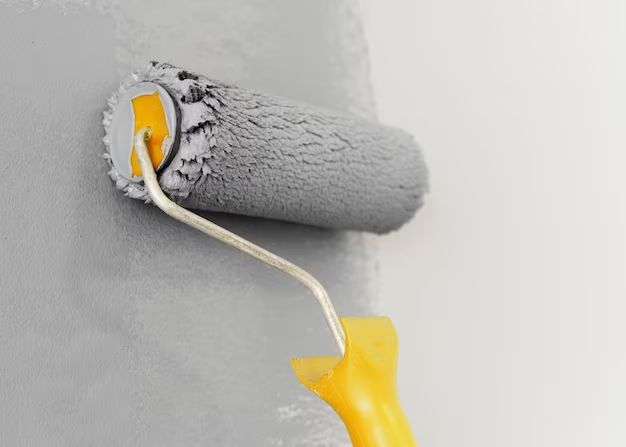When it comes to painting the walls in your home, choosing the right size roller can make all the difference in getting a smooth, professional-looking finish. The size of roller you need depends on a few key factors, including the type of paint you’re using, the texture of your walls, and the size of the area you’re painting.
Page Contents
Paint Type
The first consideration when choosing a paint roller is the type of paint you’ll be using. Here are the most common paint types and the recommended roller sizes for each:
| Paint Type | Recommended Roller Size |
|---|---|
| Latex or water-based paint | 3/8″ nap or 1/2″ nap |
| Oil-based paint | 1/4″ nap |
| Primer | 1/4″ nap or 3/8″ nap |
| Ceiling paint | 1/2″ nap or longer |
Latex and water-based paints are the most common choices for wall paint these days. A 3/8″ or 1/2″ nap roller will work best with these paints to help pickup and distribute the paint evenly.
For oil-based paints, a shorter nap like 1/4″ is recommended to avoid excess stippling or leaving too much texture from the roller. Primers can also be applied with 1/4″ or 3/8″ nap rollers.
For ceilings, a medium to long nap roller of 1/2″ or more helps apply enough paint quickly to coverage the large surface. The texture from the longer nap isn’t as much of a concern on ceilings as it would be on flat walls.
Wall Texture
The existing texture of your walls should also be taken into account when selecting a roller. Here are some guidelines based on wall texture:
| Wall Texture | Recommended Roller Size |
|---|---|
| Smooth | 3/8″ nap or 1/2″ nap |
| Lightly textured | 1/2″ nap |
| Heavily textured | 1/2″ nap or longer |
For very smooth walls like fresh drywall, plaster, or concrete, a 3/8″ or 1/2″ nap roller will be able to smooth on paint evenly. For lightly textured walls with some orange peel or knockdown texture, a 1/2″ nap is ideal.
On heavily textured walls or popcorn ceilings, choosing a longer 1/2″ or higher nap roller allows the roller to get into the grooves and textures adequately. Using too short of a nap on textured surfaces can lead to an uneven coat of paint.
Paint Area Size
The size of the space you’ll be painting should also impact your roller selection. Bigger rollers allow you to cover more ground efficiently for large wall expanses. Smaller rollers are more maneuverable for tight spaces.
| Paint Area Size | Recommended Roller Size |
|---|---|
| Small spaces | 4-inch roller |
| Medium rooms | 9-inch roller |
| Large open concept rooms | 18-inch roller |
In a small space like a bathroom, hallway, or closet, a 4-inch roller allows you to roll into corners and navigate around obstacles like fixtures. For standard sized rooms like bedrooms and offices, a 9-inch roller is the go-to size that will cover medium expanses efficiently.
For large living spaces with high ceilings and big open layouts, an extra wide roller like 18 inches can speed up painting by covering a huge swath of wall in each pass. Just be aware that larger rollers require extension poles to be able to reach higher areas.
Consider a roller system
Instead of managing multiple roller frames and covers, you can also invest in a roller painting system. These systems combine an adjustable multi-sized frame with quick change heads to easily swap different nap sizes and widths. Popular options include:
- Wooster Pro Roller Frame with screw adjustable width from 4 to 18 inches
- Purdy Colossus II roller frame expands up to 18 inches wide
- Wagner Smart Roller frames range from 4 to 18 inches using extension side handles
With a roller system, you can have the flexibility of using different size heads for ceilings, walls, and trim work. Just keep multiple nap covers on hand to easily change depending on your paint and surface type.
Choosing Roller Cover Material
Roller covers come in a range of materials like polyester, lambswool, microfiber, and foam. The material impacts the paint pickup, smoothness of application, and durability.
For DIY homeowners, here are some popular options:
| Cover Material | Features |
|---|---|
| Polyester |
|
| Microfiber |
|
| Lambswool |
|
| Foam |
|
Polyester is the most common and cost-effective choice for DIYers. It provides good versatility for most paint finishes. Microfiber makes an excellent upgrade for very smooth surfaces. Foam works well if speed is the priority and you don’t mind some stippling texture.
Conclusion
Choosing the ideal roller size and material for your paint project matters. The right roller can make painting walls quick and easy with a smooth uniform finish. Consider the type of paint, texture of your walls, size of space, and your budget when deciding on a roller setup. And don’t be afraid to have multiple width rollers and naps on hand so you always have the right tool for the job.
